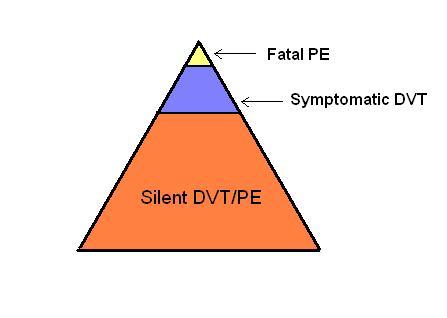Deep vein thrombosis history and symptoms: Difference between revisions
Rim Halaby (talk | contribs) |
Rim Halaby (talk | contribs) |
||
| Line 86: | Line 86: | ||
** [[Prothrombin gene mutation G20210A]] | ** [[Prothrombin gene mutation G20210A]] | ||
** [[Protein C]] or [[Protein S]] deficiency | ** [[Protein C]] or [[Protein S]] deficiency | ||
** [[Antithrombin (AT) deficiency | ** [[Antithrombin]] (AT) deficiency | ||
** [[Antiphospholipid syndrome]] (APS) | ** [[Antiphospholipid syndrome]] (APS) | ||
* '''Abortion''' | * '''Abortion''' | ||
Revision as of 13:18, 5 June 2014
Editor(s)-In-Chief: The APEX Trial Investigators, C. Michael Gibson, M.S., M.D. [1]; Associate Editor(s)-In-Chief: Cafer Zorkun, M.D., Ph.D. [2] ; Kashish Goel, M.D.; Assistant Editor(s)-In-Chief: Justine Cadet
|
Deep Vein Thrombosis Microchapters |
|
Diagnosis |
|---|
|
Treatment |
|
Special Scenario |
|
Trials |
|
Case Studies |
|
Deep vein thrombosis history and symptoms On the Web |
|
Risk calculators and risk factors for Deep vein thrombosis history and symptoms |
Overview
A proper history and physical exam is very important for establishing an accurate diagnosis of deep vein thrombosis (DVT). DVT can be either asymptomatic or associated with tenderness and swelling of the calf or thigh. One of the first steps in the management of DVT is the determination of the Wells score for DVT, whose criteria can be ascertained solely on the basis of history and physical exam. A high index of suspicion is also necessary to diagnose DVT. DVT can be complicated by pulmonary embolism (PE); therefore, it is important to inquire about the symptoms of PE among patients suspected to have DVT.
History and Symptoms
As depicted in the image below, the majority of patients with venous thromboembolism (VTE), that is DVT, PE, or both, are asymptomatic.
Common Symptoms of DVT
The classical symptoms of DVT include:
- Pain in the affected area
- Swelling of the affected area
- Erythema around the affected area
- Dilation of the surface veins and erythema of the overlying area
However, sometimes there may be no symptoms referable to the location of the DVT.
-
Front View:Edematous Right Leg
-
Rear View:Left limb edema localized to calf.
-
Front View:Left limb edema localized to calf.
Less Common Symptoms of DVT
- In phlegmasia alba dolens, the leg is pale and cold with a diminished arterial pulse.
- In phlegmasia cerulea dolens, there is an acute and near-total venous occlusion of the entire extremity outflow, including the iliac and femoral veins. The leg is usually painful, cyanosed and edematous.
Symptoms of PE
Since VTE involves both DVT and PE, the patient can present with complaints of either of the diseases. Therefore it is important to inquire about the symptoms of both diseases. Symptoms of PE include:
- Dyspnea
- Pleuritic chest pain
- Syncope
- Tachycardia
- Tachypnea
- Hypotension or shock (in case of massive PE)
Complete History
If VTE is suspected or diagnosed, a complete history should be undertaken, including the following:
- Risk factors
- Chemotherapy
- Chronic heart failure
- Respiratory failure
- Hormone replacement therapy
- Cancer
- Oral contraceptive pills
- Stroke
- Pregnancy
- Postpartum
- Prior history of VTE
- Thrombophilia
- Advanced age
- Laparoscopic surgery
- Prepartum
- Obesity
- Varicose veins
- Chemotherapy
- Triggers
- Bone fracture (hip or leg)
- Hip replacement surgery
- Knee replacement surgery
- Major general surgery
- Significant trauma
- Spinal cord injury
- Athroscopic knee surgery
- Central venous lines
- Chemotherapy
- Bed rest for more than 3 days
- Prolonged car or air travel
- Laparoscopic surgery
- Prepartum
- Bone fracture (hip or leg)
- Previous episode of VTE
- Age
- Location
- Past medical history
- History of thrombophilia
- Factor V Leiden mutation
- Prothrombin gene mutation G20210A
- Protein C or Protein S deficiency
- Antithrombin (AT) deficiency
- Antiphospholipid syndrome (APS)
- Abortion
- Abortion at second or third trimester of pregnancy (suggestive of an inherited thrombophilia or APS)
- Drugs that may induce APS
